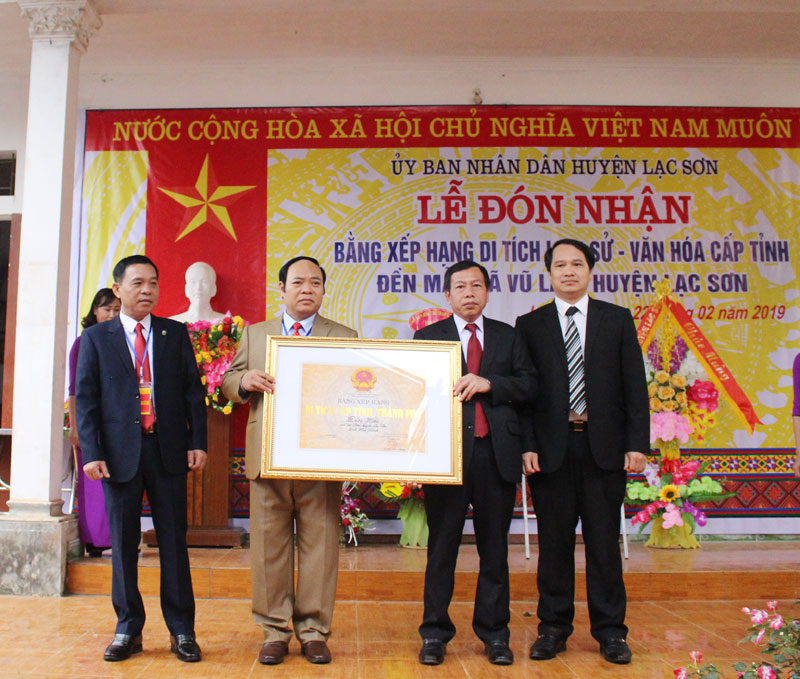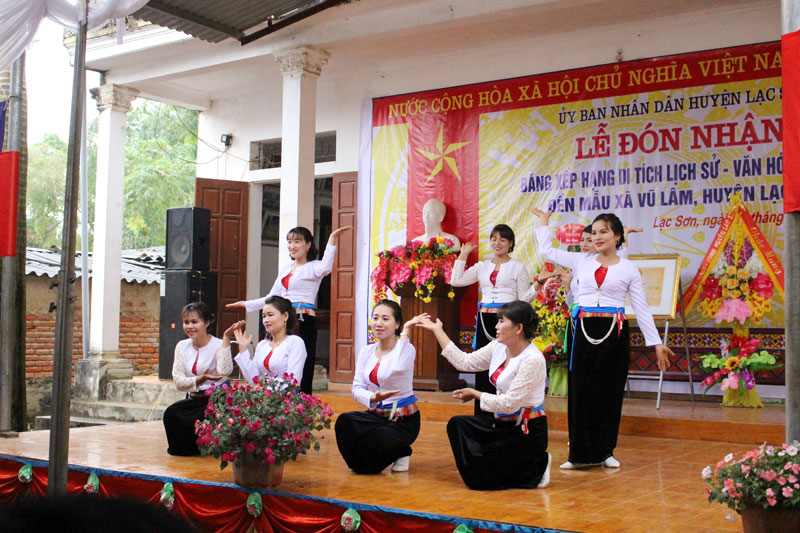
(HBO) – A ceremony was held on February 22 to receive a certificate acknowledging Mau (Mother Goddesses) temple in Vu Lam commune (Lac Son district) of the northwestern mountainous province of Hoa Binh as a provincial historical, culture relic.

Vice Director of
provincial Department of Culture, Sports and Tourism Bui Xuan Truong presents
the certificate recognising Mau temple as provincial historical, culture relic
to leaders of Vu Lam commune (Lac Son district).
The temple is located on
Lam Hoa 1 street in Vu Lam commune (Lac Son district). It was built in 1920 in
an area of about 30 sq.m. by local people, with one room and four pillars of simple
ancient architecture, along with a thatch roof and wooden walls. An altar
honouring three Mother Goddesses was placed inside the temple.
In 1922, residents of the
street donated money to improve the temple in a larger area of 100 sq.m.
The Mau temple festival of
the Muong ethnic people is celebrated on the third day of the third lunar
month, the tenth day of the six month and the twentieth day of the ninth month.
Ever since its establishment, the temple has been a centre for cultural and
communal activities where people pray for the country’s peace, fair weather and
happiness.

An art performance of the
art troupe in Vu Lam commune (Lac Son district).
To conserve and develop
traditional cultural values, on June 22, 2018, the Hoa Binh People’s Committee
issued a decision on recognising the temple as a provincial historical and
cultural relic. This is an encouragement for the authorities and people in Vu
Lam in particular and Lac Son district in general to be more determined to
enhance the values of the relic, drawing more tourists to the temple and
contributing to the culture conservation and development in Lac Son./.
Hoa Binh province has carried out multiple programmes and initiatives to revive its cultural heritage which has gradually fallen into oblivion through the ebbs and flows of history.
The most prominent and defining feature in the prehistoric era of Hoa Binh is the Hoa Binh Culture. The Culture was first discovered in Hoa Binh. The significant prehistoric culture represents not only Vietnam but also Southeast Asia and southern China. Through excavations of cave sites in the limestone regions of Hoa Binh, French archaeologist M. Colani introduced the world to a "Stone Age in Hoa Binh province – Northern Vietnam" in 1927. On January 30, 1932, the First Congress of Far Eastern Prehistorians, held in Hanoi, officially recognised the Hoa Binh Culture.
Known as the "Land of Epic History”, Hoa Binh province, the gateway to Vietnam’s northwest, boasts a strategic location and a unique cultural tapestry woven by its ethnic minority communities.
The People's Committee of Luong Son District recently held a ceremony to receive the certificate recognizing Sau Communal House in Thanh Cao Commune as a provincial-level historical and cultural site.
Recognising the importance of cultural heritage preservation in protecting and promoting the value system of Vietnamese culture, and serving socio-economic development in the new period, Party committees and local administrations in Hoa Binh province have identified it as a key task in the cultural development strategy. The province has been making efforts in mobilising resources, creating consensus among people and engaging ethnic communities in preserving and promoting cultural identity.
Hoa Binh province has captured growing attention both domestically and internationally for its distinctive cultural heritage and rich history. Most notably, it has been renowned for its famous Hoa Binh culture, considered the cradle of ancient Vietnamese civilisation. Looking ahead to significant milestones in 2025 and the 140th anniversary of province establishment in 2026, Hoa Binh Newspaper presents a comprehensive overview of the province's development across economic, social, cultural, tourism, and security domains.




